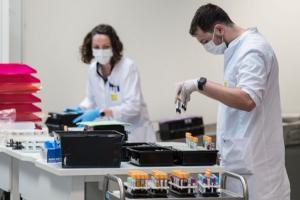Scientists from the University of Maryland School of Medicine developed the test that uses a simple assay containing plasmonic gold nanoparticles to detect a colour change when the virus is present

A laboratory staff member handles blood samples for COVID-19 screening tests at the LPA medical analysis laboratory in Besancon, eastern France. Pic/AFP
A team of US scientists led by an Indian-origin researcher has developed an experimental diagnostic test for COVID-19 that can visually detect the presence of coronavirus in 10 minutes.
ADVERTISEMENT
A team of #US scientists led by an #Indian-origin researcher has developed an experimental diagnostic test for #COVID19 that can visually detect the presence of #coronavirus in 10 minutes.#COVID_19 pic.twitter.com/r9qVw849bk
— IANS Tweets (@ians_india) May 30, 2020
Scientists from the University of Maryland School of Medicine developed the test that uses a simple assay containing plasmonic gold nanoparticles to detect a colour change when the virus is present. The test does not require the use of any advanced laboratory techniques, such as those commonly used to amplify DNA, for analysis.
"Based on our preliminary results, we believe this promising new test may detect RNA material from the virus as early as the first day of infection. Additional studies are needed, however, to confirm whether this is indeed the case," said study leader Dipanjan Pan, professor of diagnostic radiology and nuclear medicine and pediatrics.
Once a nasal swab or saliva sample is obtained from a patient, the RNA is extracted from the sample via a simple process that takes about 10 minutes. The test uses a highly specific molecule attached to the gold nanoparticles to detect a particular protein. This protein is part of the genetic sequence that is unique to the novel coronavirus.
When the biosensor binds to the virus's gene sequence, the gold nanoparticles respond by turning the liquid reagent from purple to blue. "The accuracy of any COVID-19 test is based on being able to reliably detect any virus. This means it does not give a false negative result if the virus actually is present, nor a false positive result if the virus is not present," informed Dr Pan.
Many of the diagnostic tests currently on the market cannot detect the virus until several days after infection. For this reason, they have a significant rate of false negative results. Dr Pan now plans to have a pre-submission meeting with the US Food and Drug Administration (FDA) within the next month to discuss requirements for getting an emergency use authorisation for the test.
"This RNA-based test appears to be very promising in terms of detecting the virus," said study co-author Matthew Frieman. Others in Dr Pan's team were research scientist Parikshit Moitra, research fellow Maha Alafeef, along with research fellow Ketan Dighe from the University of Maryland, Baltimore County.
The authors published their work in the American Chemical Society's nanotechnology journal ACS Nano.
Catch up on all the latest Crime, National, International and Hatke news here. Also download the new mid-day Android and iOS apps to get latest updates.
Mid-Day is now on Telegram. Click here to join our channel (@middayinfomedialtd) and stay updated with the latest news
This story has been sourced from a third party syndicated feed, agencies. Mid-day accepts no responsibility or liability for its dependability, trustworthiness, reliability and data of the text. Mid-day management/mid-day.com reserves the sole right to alter, delete or remove (without notice) the content in its absolute discretion for any reason whatsoever
 Subscribe today by clicking the link and stay updated with the latest news!" Click here!
Subscribe today by clicking the link and stay updated with the latest news!" Click here!






